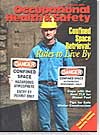
February 2003
Features
By Valerie Weadock
IT was one of the coldest, snowiest Decembers that Scott Knowlen could remember. Even after 40 years enduring Maine's heavy snowfall and average winter temperatures of around 20 degrees, the then-site safety specialist was not prepared for the 90 inches of snow this month would bring.
By Michael R. Roop
THIS report has been produced by a confined space "expert" Consultant. Expert because he knows how to spell "compliance," has been in a bunch of spaces, sometimes carries a briefcase, and is not from your hometown! The client is you: the person responsible for entries into permit required confined spaces at your site
By R. Craig Schroll
ALARM systems, as the name implies, provide an alarm or warning that a problem exists. They may be signaling systems only, which require manual activation, or the more common variety that combines detection with signaling.
By James Turner
FIRE protection is a significant concern with which all industrial facilities must contend. Depending on the location, the facility may rely on the local fire department, or it may choose to provide its own protection in the form of an industrial fire department or brigade.
By Bob Henderson, Edward J. Willwerth
DIESEL fuel is among the world's most important commodities. The United States literally runs on diesel and the other closely related "middle distillate" fuels, such as home heating oil, coal oil, gas oil, and marine diesel fuel. During August 2002, daily consumption of diesel fuel and related products in the United States averaged more than 150,000,000 gallons per day.1
By Hector V. Pazos
THIS accident happened in a large compartment of an Offshore Supply Vessel (OSV). Because of a lack of appropriate ventilation and a toxic atmosphere, it should have been treated as a confined space
By Donald A. Deieso, Ph.D., Hope S. Foster
IN the face of a still-raw tragedy more than a year ago, Americans were forced to redefine the idea of national security and the actions necessary to ensure their safety. Since then, all-too-frequent disclosures of corporate corruption have destroyed the investment accounts of millions of people, established a business climate of suspicion and fear, and resulted in scores of criminal indictments.
Departments
By Valerie Weadock
WHAT can a company do to help prevent theft, accidents, high health care costs, and lost productivity caused by sick leave and employee absences? For many, the answer is as simple as buying some plastic cups.
By Mike Williamsen, Ph.D.
THE meeting notice has been sent, the room reserved, the flip charts are in place, and the stale donuts are arranged next to the coffee. People file in and take their seats.Over the years, untold hours have been spent in safety meetings.
By Jerry Laws
TUMWATER, Wash.-- December 17, 2002--The Department of Labor and Industries said it will take whatever steps are necessary to provide protection to its inspectors and other employees in the field who occasionally encounter threatening people. A recent example occurred in Winthrop, Okanogan County, in which L&I asked the county prosecutor to file charges against a man who assaulted an L&I electrical inspector. . . .